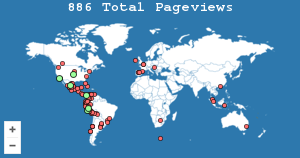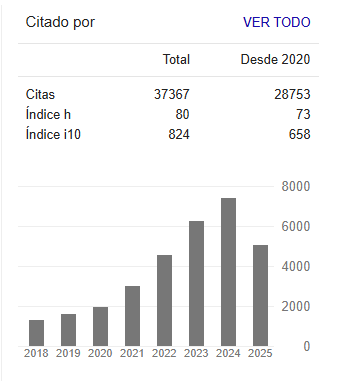Local e-government in mexico in times of covid-19
Abstract
The objective of this study was to determine the effect of the factors sufficiency and efficiency of e-services websites at the municipal (local) level on the intention of use by citizens. To test the hypothesis, a survey was applied with 12 items divided into three blocks with questions designed through a 5-degree Likert scale; the data analysis was applied using a descriptive analysis, linear regression and Pearson correlation. The instrument was applied to citizens of the State of Veracruz, Mexico during the beginning of the COVID-19 pandemic. The results indicate that there is a positive correlation between the sufficiency and efficiency factors and the intention of use, indicating that the citizen’s perspective is motivated by the sufficiency and efficiency of e-government websites.
References
Agata, A. (2018). Usability and functionality of websites of commune offices as stimulants of sustainable development of e-government. SHS Web of Conferences, 57, 1-11. https://doi.org/10.1051/shsconf/20185701029
Agostino, D., Arnaboldi, M., y Diaz, M. (2020). New development: COVID-19 as an accelerator of digital transformation in public service delivery. Public Money & Management, 1-4. https://doi.org/10.1080/09540962.2020.1764206
Byun, D-H. y Finnie, G. (2010). Evaluating usability, user satisfaction and intention to revisit for successful e-government websites. Electronic Government, and International Journal, 8(1). https://doi.org/10.1504/EG.2011.037694
Chan, C.H., y Almaghalsah, H. (2020). Usability evaluation of e-government websites: A case study from Taiwan. International Journal of Data and Network Science, 4(2), 127-138. https://doi.org/10.5267/j.ijdns.2020.2.004
Davis, F.D. (1989). Perceived usefulnes, perceived ease of use, and user acceptance of information technology. MIS Quarterly, 13(3).
ElKheshin, S., y Saleeb, N. (2020). Assessing the adoption of e-government using TAM model: case of Egypt. International Journal of Managing Information Technology, 12(1), 1-14. https://doi.org/10.5121/ijmit.2020.12101
Frias-Navarro, D. (2019). Apuntes de consistencia interna de las puntuaciones de un instrumento de medida. Universidad de Valencia. España. https://www.uv.es/friasnav/AlfaCronbach.pdf
Gozgor, G. (2020). Global Evidence on the Determinants of Public Trust in Governments during the COVID-19. Cesifo Working Papers, 1(8313), 1-19. https://ssrn.com/abstract=3618837
Hariguna, T., Lai, M., Hung, C.W., y Chen, S.C. (2017). Understanding information system quality on public e-government service intention: an empirical study. International Journal of Innovation and Sustainable Development, 11(2-3). https://doi.org/10.1504/IJISD.2017.083290
Kofi, I. (2017). Citizens’ Readiness to Adopt and Use E-government Services in the City of Harbin, China. International Journal of Public Administration, 41(4), 297-307. https://doi.org/10.1080/01900692.2016.1263658
Li, Z., Li, J., y Li, X. (2009). A Study on Website Operation Efficiency Evaluation: Based on DEA Model. International Conference on Management and Service Science, Wuhan, 1-6, https://doi.org/10.1109/ICMSS.2009.5301119
Nawafleh, S. (2018). Factors affecting the continued use of e-government websites by citizens: An exploratory study in the Jordanian public sector. Transforming Government: People, Process and Policy, 12(3/4), 244-264. https://doi.org/10.1108/TG-02-2018-0015
Pinandito, A., Az-zahra, H. M., Fanani, L., y Putri, A. V. (2017). Analysis of web content delivery effectiveness and efficiency in responsive web design using material design guidelines and User Centered Design. 2017 International Conference on Sustainable Information Engineering and Technology (SIET), Malang, 435-441, https://doi.org/10.1109/SIET.2017.8304178.
Shareef, M.A., Kumar, V., Kumar, U. y Dwivedi, Y. K. (2010). e-Government Adoption Model (GAM): Differing service maturity levels. Government Information Quarterly, 28, 17–35.
Soneka, P.N. and Phiri, J. (2019) A Model for Improving E-Tax Systems Adoption in Rural Zambia Based on the TAM Model. Open Journal of Business and Management, 7, 908-918. https://doi.org/10.4236/ojbm.2019.72062
Singh, T., Malik, S., y. Sarkar, D. (2016). E-commerce website quality assessment based on usability, 2016 International Conference on Computing, Communication and Automation (ICCCA). Noida, 101-105. https://doi.org/10.1109/CCAA.2016.7813698.
Taddeo, M. (2020). The Ethical Governance of the Digital During and After the COVID‐19 Pandemic. Minds and Machines Springer, 1-6. https://doi.org/10.1007/s11023-020-09528-5
U-GOB (2018). Ranking de Portales de Gobierno Estatal 2018. https://u-gob.com/ranking-de-portales-de-gobierno-estatal-2018/
Venkatesh, V., y Bola, H. (2008). Technology acceptance model 3 and a research agenda on interventions, Decision Sciences, 39 (2), 273-315.
Venkatesh, V., y Davis, F. (2000). A theoretical extension of the technology acceptance model: four longitudinal field studies, Management Science, 46 (2), 186-204.
Venkatesh, V., Morris, M., Davis, B., y Davis, F. (2003). User Acceptance of Information Technology: Toward a Unified View. MIS Quarterly, 27(3), 425–478.
Xie, Q., Song, W., Peng, X., y Shabbir, M. (2017). Predictors for e-government adoption: integrating TAM, TPB, trust and perceived risk. The Electronic Library, 35(1), 2-20. https://doi.org/10.1108/EL-08-2015-0141
Zárate J.A., Rosales, A., Guerrero M.G., Ríos, B.O., y Rivera, P. (2020). Measuring the facility of use of a website designed with a methodology based on concepts of design of ontologies. International Journal of Innovation Engineering and Science Research, 2(4), 33-41. http://www.ijiesr.com/liebrary/e15/9114259909.pdf








.png)






























